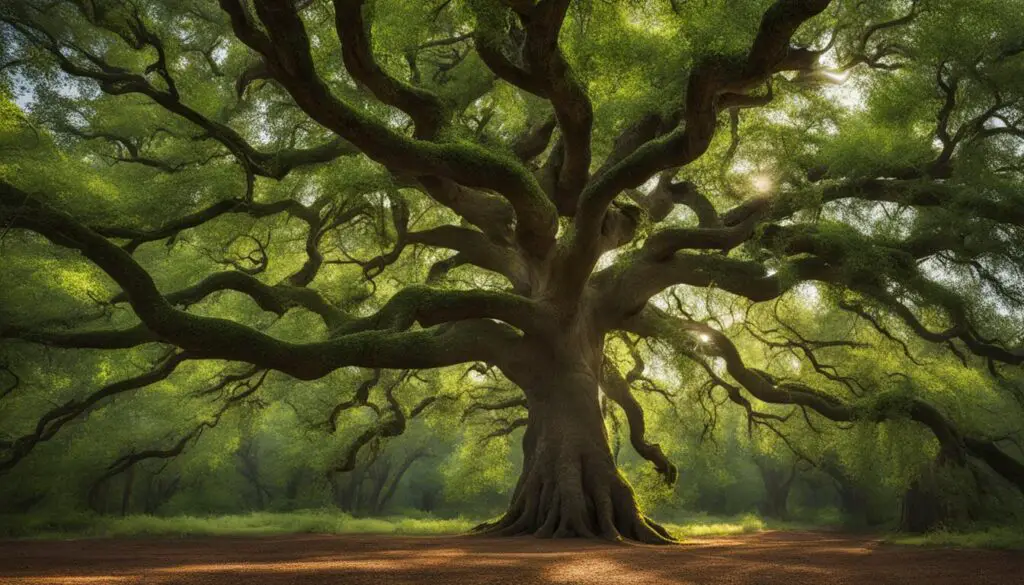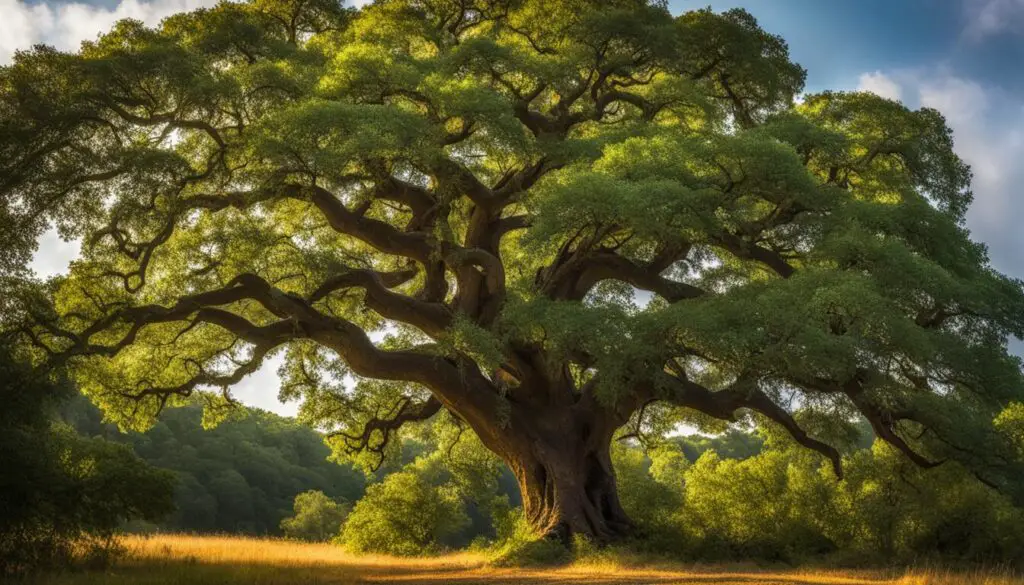Oak trees are renowned for their majestic size and impressive presence in any landscape. If you’ve ever wondered how big oak trees can get, you’re in the right place. In this article, we’ll explore the average height, dimensions, and growth of oak trees, as well as the factors that can influence their size. So, let’s delve into the fascinating world of oak tree growth!
Key Takeaways:
- Oak trees can grow up to an average height of 70 feet and have a spread of nearly 150 feet.
- Factors such as species, growing conditions, and overall tree health can influence the size of oak trees.
- The tallest recorded oak tree was 123 feet tall, showcasing the incredible growth potential of this tree species.
- Oak trees are the National Tree of America, symbolizing strength and unity.
- Planting an oak tree can attract a variety of wildlife and add a sense of resilience and enduring beauty to your landscape.
Factors Affecting Oak Tree Size
The size of an oak tree is influenced by several factors. One of the main factors is the specific species of oak tree. There are hundreds of different oak tree varieties, each with its own growth characteristics. Some species may naturally grow taller or wider than others, resulting in variations in the mature size of oak trees.
Another factor that can affect oak tree size is the availability of nutrients in the soil. Oak trees require certain nutrients, such as nitrogen and phosphorus, for healthy growth. If the soil lacks these essential nutrients, it can hinder the tree’s overall size and development.
Access to sunlight is also crucial for oak tree growth. Like many other plants, oak trees need ample sunlight to carry out photosynthesis and produce energy. If a tree is overshadowed by other taller trees or structures, it may receive less sunlight and experience stunted growth as a result.
The climate conditions in which an oak tree grows can also impact its size. Different oak tree species have varying levels of tolerance to cold or hot temperatures, drought, and humidity. Some species may thrive in certain climates, while others may struggle to reach their full size potential under less favorable conditions.
Lastly, the overall health of the tree plays a significant role in determining its size. Factors such as diseases, pests, and damage can weaken an oak tree and restrict its growth. Regular maintenance and proper care, including watering, pruning, and protection against potential threats, can help ensure the health and vigor of oak trees, allowing them to reach their mature size.
Considering these various factors can help individuals make informed decisions when selecting and caring for oak trees on their property. By choosing the right species, providing adequate nutrients and sunlight, maintaining a suitable climate, and prioritizing tree health, individuals can maximize the potential size and beauty of their oak trees.
Average Oak Tree Height and Width
When it comes to the majestic oak tree, size is definitely one of its standout characteristics. On average, an oak tree can reach a height of around 70 feet. However, the actual height can vary depending on the specific species and the environmental conditions in which it grows.
But height isn’t the only factor that contributes to the grandeur of an oak tree. These magnificent trees also have an impressive spread, or width, that can extend up to 150 feet. This wide canopy provides ample shade and creates a commanding presence in any landscape.
It’s important to note that these height and width measurements are just averages. Some oak trees can grow even taller and wider, depending on their genetic makeup and the conditions in which they thrive.

To get a more accurate idea of the size of different oak tree species, you can refer to an oak tree size chart. This chart provides specific measurements for the height and width of each variety, allowing you to choose the perfect oak tree for your outdoor space.
Tallest Oak Trees in the World
While the average height of oak trees is around 70 feet, some oak trees have reached incredible heights, showcasing the remarkable growth potential of this species. The following table highlights the tallest oak trees recorded around the world:
| Oak Tree | Location | Height (feet) |
|---|---|---|
| White Oak | Maryland, USA | 123 |
| Jomon Sugi Oak | Japan | 83 |
| Angel Oak | South Carolina, USA | 66 |
These towering oak trees serve as testaments to the exceptional heights that some oak trees can reach. The white oak in Maryland is the tallest oak tree on record, standing at an astonishing 123 feet tall. It is followed by the Jomon Sugi oak tree in Japan, which reaches a height of 83 feet, and the Angel Oak in South Carolina, standing at 66 feet tall.
Oak Trees as the National Tree of America
In 2004, the oak tree was chosen as the National Tree of America to symbolize the strength and unity of the nation. This recognition highlights the significance of oak trees in American culture and history.
Oak trees are renowned for their tall height and wide spread, making them a fitting representation of the grandeur and endurance associated with the United States. With an average height of 70 feet and a spread of nearly 150 feet, oak trees dominate the landscape and create an imposing presence.
Planting an oak tree on your property not only adds beauty, but also showcases your patriotic spirit. It is a powerful way to connect with nature and honor the national symbol. As the National Tree of America, the oak tree carries a sense of pride and reverence, reminding us of our shared heritage and the strength of our nation.
Benefits of Planting an Oak Tree
- Enhances the aesthetic appeal of your property
- Provides shade and cooling benefits
- Supports biodiversity by attracting various wildlife species
- Contributes to cleaner air and reduced pollution
- Acts as a natural windbreaker, protecting against harsh weather conditions
By planting an oak tree, you not only contribute to the preservation of a significant part of American culture, but also create a legacy that will endure for generations to come.

Comparison of Oak Tree Size with Other National Trees
| National Tree | Average Height (feet) | Average Spread (feet) |
|---|---|---|
| Oak Tree (National Tree of America) | 70 | 150 |
| Pine Tree (National Tree of Canada) | 80 | 40 |
| Giant Sequoia (National Tree of the USA) | 250 | 100 |
| Olive Tree (National Tree of Greece) | 30 | 40 |
As shown in the table above, the oak tree stands out with its impressive height and spread compared to other national trees. This further highlights its significance as the National Tree of America.
Oak Trees as a Habitat for Wildlife
Oak trees play a vital role in supporting wildlife ecosystems. The production of acorns by oak trees provides a valuable food source for many animals, including squirrels, birds, and deer. Planting an oak tree in your yard can attract a variety of wildlife, allowing you to observe and appreciate the natural beauty around you. The large size and longevity of oak trees also make them ideal habitats for birds and other creatures, providing shelter and nesting sites.
As oak trees grow and mature, they become essential feeding grounds and nesting sites for numerous species. The canopy of an oak tree offers protection from predators and harsh weather conditions, creating a safe haven for birds to build their nests. Branches provide sturdy platforms for constructing intricate nests, while the leaves offer ample cover for hiding eggs and young chicks.
The production of acorns by oak trees plays a crucial role in feeding wildlife. Acorns are rich in nutrients and serve as a vital food source for many animals. Squirrels, in particular, heavily rely on acorns as a primary food source and often store them for winter survival. Other animals, such as deer and wild turkeys, also benefit from the abundance of acorns provided by oak trees.
The feeding habits of wildlife attracted to oak trees contribute to the dispersal of acorns and aid in the oak tree’s growth and survival. Animals help in the distribution of acorns by burying them in various locations, unintentionally planting new oak trees. This symbiotic relationship between oak trees and wildlife helps ensure the continued propagation and expansion of oak populations.
Wildlife Species Supported by Oak Trees
| Wildlife Species | Role |
|---|---|
| Squirrels | Primary consumers of acorns, assist in seed dispersal |
| Birds | Build nests in oak tree branches, help control insect populations |
| Deer | Feed on acorns, aid in seed dispersal |
| Wild Turkeys | Feed on acorns, aid in seed dispersal |
By planting and preserving oak trees, you not only enhance the beauty of your surroundings but also provide valuable resources for wildlife. These majestic trees serve as natural habitats, sustaining diverse ecosystems and promoting the well-being of various animal species. Embrace the opportunity to coexist with nature by welcoming oak trees into your landscape, creating a haven for wildlife to thrive.
Symbolic Meaning of Oak Trees
Oak trees are not only impressive in size, but they also hold symbolic meaning. Throughout history, oak trees have been associated with wisdom, courage, and endurance. The height, long lifespan, and deep roots of oak trees represent the ability to withstand challenges and adapt to changing circumstances. Adding an oak tree to your property can bring a sense of strength and resilience to your landscape, as well as a connection to the rich traditions and folklore surrounding this iconic tree.

| Symbolism | Description |
|---|---|
| Wisdom | The oak tree is often associated with wisdom and knowledge due to its long lifespan and ability to adapt to various environmental conditions. |
| Courage | Symbolizing strength and bravery, oak trees have historically been linked to the virtues of courage and resilience. |
| Endurance | With its deep roots and ability to withstand harsh weather conditions, the oak tree represents endurance and the ability to persevere. |
| Connection to Tradition | Oak trees have a rich history in folklore and mythology, making them a symbol of tradition and deep-rooted cultural significance. |
Whether you’re looking to add a touch of symbolism to your landscape or simply admire the beauty of oak trees, their presence can bring a sense of strength and resilience to your outdoor space. The enduring symbolism of oak trees serves as a reminder of the power and significance of nature in our lives.
Oak Tree Distribution and Habitat
Oak trees are widely distributed across different continents, including Europe, Asia, and North America. In Europe, the two most common oak tree species are the sessile oak and the pedunculate oak. The sessile oak is predominantly found in the North and West of the continent, while the pedunculate oak has a wider distribution ranging from Western Europe to the Baltic states.
Oak trees thrive in a variety of habitats, showcasing their adaptability to different environments. They are commonly found in temperate deciduous forests, where they contribute to the rich biodiversity of these ecosystems. Oak trees can also grow in mountainous regions, providing stability to the soil and serving as an essential part of the mountainous landscape.

However, with the expansion of agriculture and land conversion, the availability of suitable habitat for oak trees has decreased. As a result, oak tree populations have faced challenges in maintaining their natural habitats. Conservation efforts are necessary to protect and preserve these iconic trees for future generations to enjoy.
Conclusion
In conclusion, oak trees are renowned for their impressive growth and size. They can reach heights of up to 70 feet on average and have a spread of nearly 150 feet. With a lifespan of up to 1,000 years, oak trees are a long-lasting investment that can enhance the beauty and grandeur of any landscape.
Various factors, such as the specific oak tree species, growing conditions, and overall tree health, can influence their size. However, regardless of these factors, planting an oak tree not only provides aesthetic appeal but also supports wildlife habitats.
Symbolically, oak trees represent strength and endurance. They have been associated with wisdom and courage throughout history, standing tall and resilient in the face of challenges. By planting an oak tree, you can bring these symbolic meanings to your outdoor space, adding a sense of connection to the rich traditions and folklore surrounding this iconic tree.
In conclusion, whether you’re considering planting an oak tree for its practical benefits or the symbolic value it brings, you can be assured that it will make a grand statement in any outdoor setting. So, why not embark on this rewarding journey of nurturing an oak tree and witnessing its majestic growth?
FAQ
How big do oak trees get?
Oak trees can grow up to an average height of 70 feet and have a spread of nearly 150 feet. However, some oak trees can be even taller and wider.
What factors affect oak tree size?
The size of an oak tree is influenced by several factors, including the specific species, availability of nutrients in the soil, access to sunlight, climate conditions, and overall tree health.
What is the average height and width of an oak tree?
The average height of an oak tree is around 70 feet, while the width, or spread, can reach up to 150 feet. For specific measurements of different oak tree species, you can refer to an oak tree size chart.
What are the tallest oak trees in the world?
The tallest oak tree on record was a white oak in Maryland, USA, measuring 123 feet tall. Other notable tall oak trees include the Jomon Sugi oak in Japan (83 feet) and the Angel Oak in South Carolina, USA (66 feet).
Why are oak trees the National Tree of America?
Oak trees were chosen as the National Tree of America in 2004 to symbolize strength and unity. Their tall height and wide spread represent the grandeur and endurance associated with the United States.
How do oak trees support wildlife ecosystems?
Oak trees produce acorns, which provide a valuable food source for many animals such as squirrels, birds, and deer. The large size and longevity of oak trees also make them ideal habitats for birds and other creatures, providing shelter and nesting sites.
What is the symbolic meaning of oak trees?
Throughout history, oak trees have been associated with wisdom, courage, and endurance. Their height, long lifespan, and deep roots represent the ability to withstand challenges and adapt to changing circumstances.
Where are oak trees distributed and what is their habitat?
Oak trees are found throughout most of Europe and parts of Asia and North America. In Europe, the two most common species are the sessile oak and the pedunculate oak, which thrive in various habitats, from deciduous forests to mountainous regions.
Why should I consider planting an oak tree?
Planting an oak tree provides beauty, shade, and supports wildlife habitats. It also represents strength, endurance, and a connection to rich traditions and folklore. Oak trees can make a grand statement in any outdoor space.

